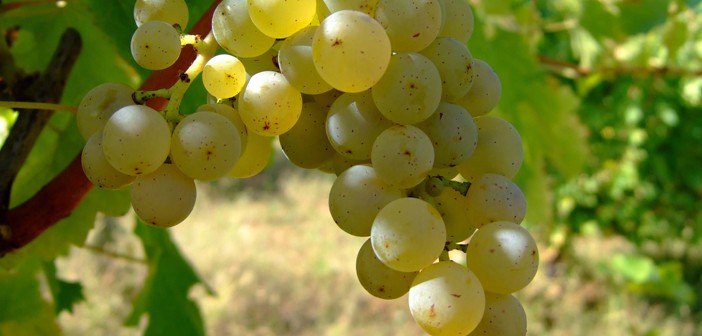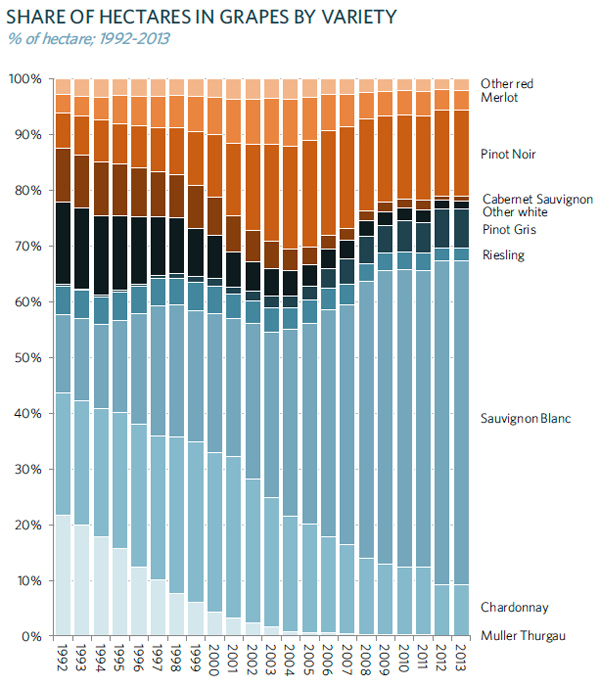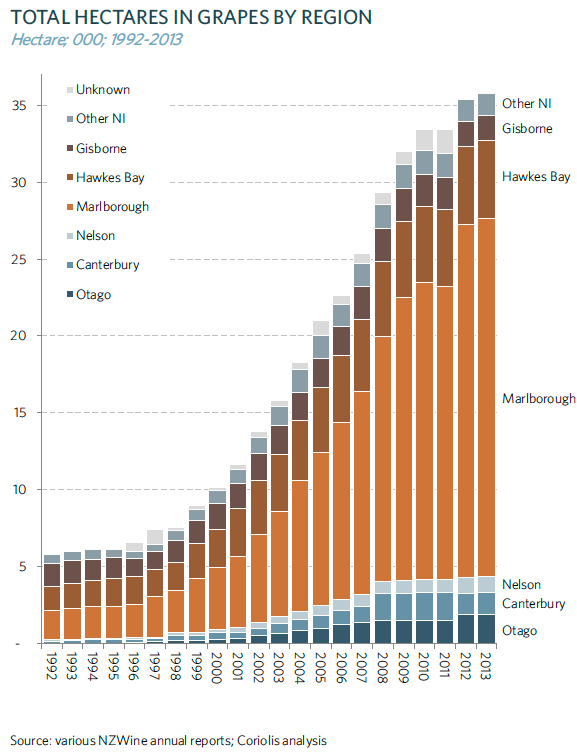Beyond Sauvignon Blanc: the future of New Zealand wine exports


The NZ wine industry & New Zealand wine exports are overly reliant on Marlborough Sauvignon Blanc. So, what’s next?
The NZ wine industry had an estimated turnover of $2 billion in 2014, with export earnings making up $1.33 billion of this. The goal is to achieve $2 billion in just export earnings by 2020.
The double-edged sword of Sauvignon Blanc
It was Sauvignon Blanc, particularly from the Marlborough region, that put NZ wines on the international map. It has become a “must-have” wine the world over.

Source: ‘iFAB 2013 Beverages Review’ – a report from Coriolis for the NZ Government’s Food and Beverages Review, January 2014.
But whilst Marlborough Sauvignon Blanc has done a great job, its success is also limiting. The Marlborough wine area is almost completely used up, so the geography is preventing expansion. (It is interesting to note that the Marlborough area is planted with almost as many grapes as the Burgundy area of France.)
However, the Coriolis/NZ Government report of July 2014 (‘What does Asia want for dinner? A drink’) is on the right track in describing the NZ wine industry as “still too much of a ‘one-trick-pony’ with an over-reliance on Marlborough Sauvignon Blanc; need to diversify.”
So – what’s next? What about Central Otago? Or Waipara? Or Hawkes Bay?
There are many emerging wine regions that are well known in NZ, such as Central Otago, Waipara and Hawkes Bay. However, these regions haven’t had their breakthroughs in overseas markets: these regions and wines are mostly undiscovered outside of New Zealand.
The chart below demonstrates just how vast the Marlborough region is compared to other NZ wine regions. The other regions are considered to be 20 years behind in their development.

Source: ‘iFAB 2013 Beverages Review’ – a report from Coriolis for the NZ Government’s Food and Beverages Review, January 2014.
So what are the opportunities for NZ wine exports?
The obvious opportunities might be to promote and sell other NZ wine varieties more widely overseas. And to promote and sell other regions. However, all that overseas promotion costs money – and what can be grown profitably in NZ is dictated by climate and soil conditions.
Digging a bit deeper, there may well be opportunities to grow NZ wine exports to China and Asia: these regions currently make up just 3% in export volumes. These regions have a mega-trend for premium brands and gifting, so there’s an opportunity for NZ wineries to create premium brands through marketing and advertising.
Wine packaging also has a role, not just in branding, but also to tap into the gifting trend by making the wine experience about more than the flavour, but the overall brand experience.
Summary
- Sauvignon Blanc is the most widely-grown grape in New Zealand – by a long way.
- Marlborough is the largest wine-growing region in New Zealand – by a long way.
- The Marlborough wine area is almost completely used up, so the geography is preventing expansion.
- Other NZ wine-growing regions are considered to be 20 years behind in their development.
- For New Zealand wine exports – and the industry as a whole – to be sustainable, the industry needs to develop opportunities that might present themselves. This may include promoting other NZ grape varieties and growing regions overseas more heavily.
- There are further opportunities to develop New Zealand wine exports into Chinese and Asian markets, for example by creating premium brands and tapping further into the gifting trend.
Sources:
- Vintage 2014: New Zealand wine industry benchmarking survey’ – a joint publication from Deloitte and New Zealand Winegrowers, December 2014.
- ‘iFAB 2013 Beverages Review’ – a report from Coriolis for the NZ Government’s Food and Beverages Review, January 2014.
- ‘What does Asia want for dinner? A drink’ – a report from Coriolis for the NZ Government’s Food and Beverages Review, July 2014.
